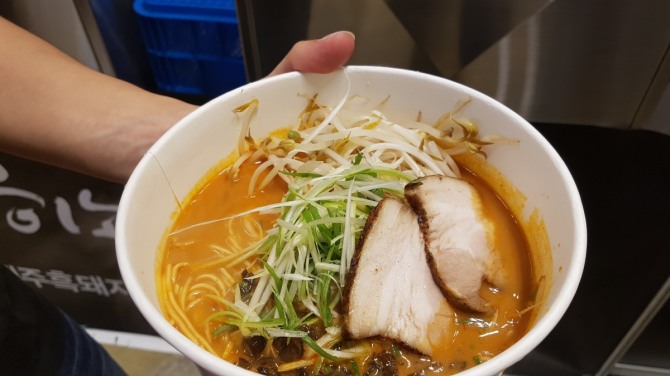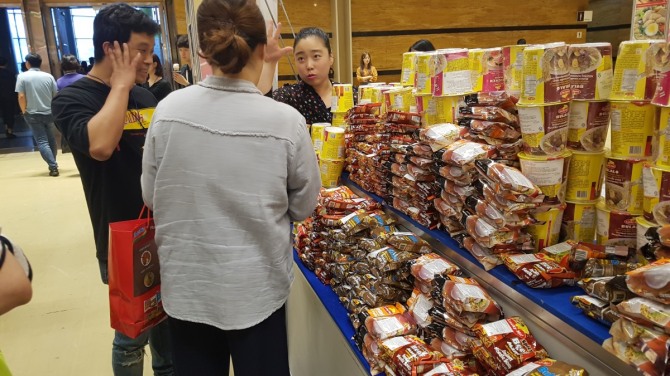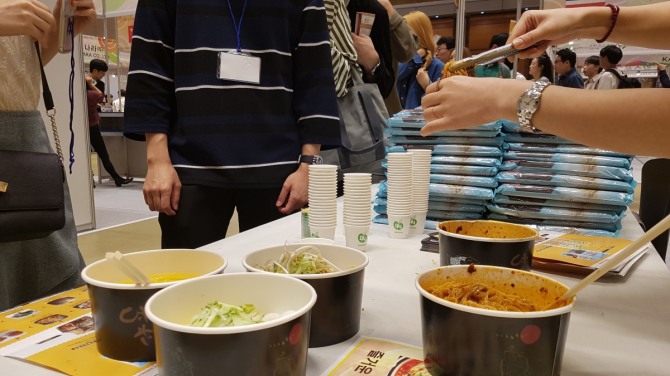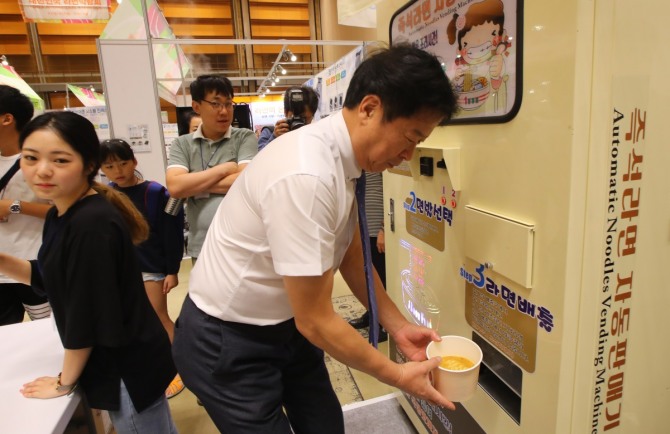Home > Feature
Ever-expanding universe of ramen
Barley, maize noodles and self-cookers lead Korean ramen trends
 |
| A visitor holds a bowl of Japanese ramen at the Ramen Fair at Coex on Sunday. (Rumy Doo/The Korea Herald) |
Korea is the leading consumer of ramen per person in the world, with each person eating about 76 bowls per year, according to the Ministry of Agriculture, Food and Rural Affairs.
The dish’s popularity was palpable at the annual Ramen Fair that took place at the Coex Convention and Exhibition Center in Seoul from Saturday to Monday. In its third year, some 80 companies set up 230 booth at the fair.
On Sunday, the fair was packed with groups of friends, families and solo visitors standing in long lines to try different types of ramen.
International ramen brands abounded. Available for purchase were China’s Kangshifu, Bijia, Qiaqia and Baixiang; Indonesia’s Indomie and ABC; Thailand’s Mama, Waiwai and Yum Yum; and Vietnam’s Acecook. Japanese ramen, especially popular in Korea, took up a significant portion of the fair with brands such as Itomen. These ramen brands incorporated the traditional cuisine of the countries, such as China’s spicy hot pot known as malatang, Japanese miso and Vietnamese rice noodles incorporated into the dishes.
 |
| Visitors purchase Chinese ramen at the Ramen Fair at on Sunday. (Rumy Doo/The Korea Herald) |
Ramen makers from different parts of the country sought to create healthier forms of ramen with noodles made from non-flour, low-gluten ingredients that are specialties in their regions.
Macsobahn is a company that makes ramen with organic barley grown in Goseong County, South Gyeongsang Province, and rice. The noodles are 60 percent barley, with potato starch added for firmness.
Barley ramen has been in development for five years and was launched this year, said Je Hae-soo, the CEO of Macsobahn. “We’ve taken out MSG entirely and added more concentrated natural flavoring,” he said. “It’s pricier, but there’s a higher demand for healthy ramen options. I’m finding that consumers are willing to pay slightly higher prices.”
 |
| Visitors stand in line to sample ramen at the Ramen Fair at Coex on Sunday. (Rumy Doo/The Korea Herald) |
“There is a sweeter, cleaner taste to the broth,” said 35-year-old restaurant owner Kim Jae-seon at the fair. He had the ramen at last year’s event.
Alali Food, first established in Yanbian Korean Autonomous Prefecture in China, has devised a method of making noodles with 100 percent corn maize, zero sodium and no preservatives. The method has been patented in China.
“It’s not deep fried. No additional sodium is added. It goes through a drying process that we’ve developed and perfected,” said the company’s CEO Lee Chang-wook.
“Our philosophy is to make food that is green, healthy and safe. We’re trying to come up with ways to make noodles with zero additives, but which preserves the natural nutrients of the grains we use.”
“This year, we’ve focused on bringing in foreign brands and independent local brands from different regions that are harder to find in the market, rather than well-known ramen brands that everyone can easily access,” said Hong Whee-sun, director of the Ramen Fair executive office. “We sought diversity and differentiation.”
 |
| A man pulls out a bowl of ramen from a ramen vending machine, similar to a pressure cooker, at the Ramen Fair held at Coex Convention and Exhibition Center on Sunday. (Yonhap) |
The stoves retail at about 1.5 million won ($1,325). Users are able to boil ramen on disposable foil dishes and add ingredients to their liking.
“Buyers say that people like the do-it-yourself cooking experience,” said Choi.
By Rumy Doo (doo@heraldcorp.com)




























